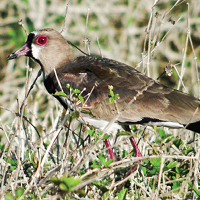Conservation implications of multiple habitat use by Northern Waterthrushes during the non-breeding season
Main Article Content
Abstract: Using evidence from individually-marked birds and radio-telemetry, we studied daily and seasonal habitat use of Northern Waterthrushes (Seiurus novaboracensis) in Puerto Rico during the nonbreeding season from 1999 to 2001. Our study was conducted in mangrove habitats along the southwest and east coasts and near ponds and washes in mesquite savanna in the southwest. Of 29 radio-equipped birds we found a dominant pattern of overnight roosting (87.8% of radioed birds) in coastal red mangroves (Rhizophora mangle), regardless of the habitat used for daytime feeding. Birds left feeding areas just before dusk, sometimes flying as far as 1.8 km to coastal red mangroves. These same birds returned to their feeding areas over a broader range of times the following morning. We also observed individuals shift feeding areas (60.0% of birds followed for 3 or more days) over the course of days, weeks, and months. The combination of daily movements between habitats and longer term shifting of feeding areas suggests that this species selects multiple habitats that meet daytime feeding and night-time roosting requirements. Due to these movements, habitat preferences of individual birds cannot be inferred from short-term diurnal censuses or mist net data alone. These findings document the need to consider multiple habitats as well as habitat mosaics when conserving Northern Waterthrushes and other species.
Keywords: habitat use, Northern Waterthrush, Puerto Rico, Seiurus novaboracensis
Resumen: Implicaciones conservacionistas del uso de múltiples hábitat por Seiurus novaboracensis durante la estación no reproductiva- Estudiamos mediante individuos marcados y radiotelemetría, el uso de hábitat diario y estacional de Seiurus novaboracensis en Puerto Rico, durante las estaciones no reproductivas de 1999 al 2001. Nuestro estudio se desarrollo en manglares a lo largo de las costas este y suroeste y en lagunas de las sabanas del suroeste. De 29 individuos marcados con radio encontramos un patrón dominante de descanso nocturno en áreas costeras de mangle rojo (Rhizophora mangle) (87,8% de las aves con radiotransmisores), independientemente del tipo de hábitat empleado para la alimentación durante el día. Las aves abandonaron sus áreas de alimentación justo antes del atardecer; en ocasiones volando hasta 1,8 km hacia las áreas costeras de mangle rojo. Estos mismos individuos regresaron a las áreas de alimentación en la mañana siguiente en un rango más amplio de tiempo. También observamos individuos que cambiaron sus áreas de alimentación (60,0% de las aves monitoreados por tres o más días) durante los días, semanas y meses. La combinación de los movimientos diarios entre los hábitat y los cambios a largo plazo de las áreas de alimentación sugiere que esta especie selecciona hábitat múltiples que cumplimentan sus requerimientos de alimentación durante el día y de descanso durante la noche. Debido a estos movimientos, las preferencias de hábitat de aves individuales no pueden ser inferidas a partir de censos diurnos a corto plazo o de las capturas en las redes ornitológicas solamente. Estos hallasgos apoyan la necesidad de considerar los hábitat múltiples y los mosaicos de hábitat cuando hablamos de la conservación de Seiurus novaboracensis y otras especies.
Palabras claves: Puerto Rico, Seiurus novaboracensis, Señorita de Manglar, uso de hábitat
References
(Seiurus novaboracensis). In The Birds of North
America, No. 182 (A. Poole and F. Gill, eds.).
Philadelphia: Academy of Natural Sciences;
Washington, DC: American Ornithologists’ Union.
GREENBERG, R. 1984. The winter exploitation systems
of Bay-breasted and Chestnut-sided Warblers
in Panama. Univ. Calif. Publ. Zool. 116:1-
107.
HOLMES, R. T. AND T. W. SHERRY. 1992. Site
fidelity of migratory warblers in temperate
breeding and Neotropical wintering areas: implications
for population dynamics, habitat selection,
and conservation. Pp. 563-575 in Ecology
and Conservation of Neotropical Migrant
Landbirds (J. M. Hagan and D. W. Johnston,
eds.). Washington, DC: Smithsonian Institution
Press.
HUNT, P. D., L. R. REITSMA, S. L. BURSON III, AND
B. B. STEELE. 2005. Spatial and temporal distribution
of Northern Waterthrushes among nonbreeding
habitats in southwestern Puerto Rico.
Biotropica 37:697-701.
LEFEBVRE, G., AND B. POULIN. 1996. Seasonal
abundance of migrant birds and food resources in
Panamanian mangrove forests. Wilson Bull.
108:748-759.
LEFEBVRE, G., B. POULIN, AND R. MCNEIL. 1992.
Abundance, feeding behavior, and body condition
of Nearctic warblers wintering in Venezuelan
mangroves. Wilson Bull. 104: 400-412.
MARRA, P. P., T. W. SHERRY, AND R .T. HOLMES.
1993. Territorial exclusion by a long-distance
migrant warbler in Jamaica: a removal experiment
with American Redstarts (Setophaga ruticilla).
Auk 110:565-572.
PYLE, P., S. N. G. HOWELL, R. P. YUNICK, AND D.
F. DESANTE. 1987. Identification guide to North
American passerines. Slate Creek Press, Bolinas,
CA.
REITSMA, L., P. HUNT, S. L. BURSON, III, AND B.
B. STEELE. 2002. Site fidelity and ephemeral
habitat occupancy: Northern Waterthrush use of
Puerto Rican black mangroves during the nonbreeding
season. Wilson Bull. 114:99-105.
SCHWARTZ, P. 1964. The Northern Waterthrush in
Venezuela. Living Bird 3:169-184.
STAICER, C. 1992. Social behavior of the Northern
Parula, Cape May Warbler and Prairie Warbler
wintering in second-growth forest in southwestern
Puerto Rico. Pp. 308-320 in Ecology and
Conservation of Neotropical Migrant Landbirds
(J.M. Hagan and D. W. Johnston, eds.). Washington,
DC: Smithsonian Institution Press.
WINKER, K., J. H. RAPPOLE, AND M. A. RAMOS.
1990. Population dynamics of the Wood Thrush
(Hylocichla mustelina) on its wintering grounds
in southern Veracruz, Mexico. Condor 92:444-
460.
WUNDERLE, J. M., JR., AND R. B. WAIDE. 1993.
Distribution of overwintering Nearctic migrants
in the Bahamas and Greater Antilles. Condor
95:904-933.

